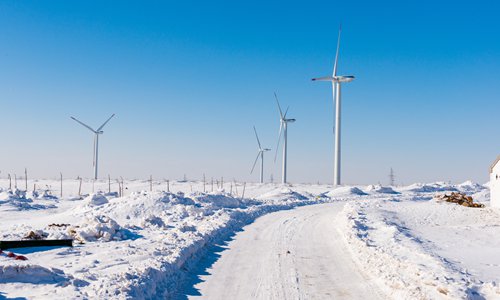Wind power ‘often wasted’ for lack of grid access
Nation's No.3 electricity source needs more support: experts

Wind turbines in Zhangjiakou, North China's Hebei Province Photo: CFP
The wind power industry has problems such as idle capacity, but it will become a major electricity source as China seeks to make its energy consumption portfolio greener, experts said.An article began to circulate on Wednesday on the Internet criticizing the subsidies that have gone into China's renewable energy industry and calling renewable power a fraud and a waste of investment.
The article, from a new-media outlet named mbcaijing, said China in recent years boosted its wind power capacity to account for about one-third of the world's total. But it also noted that many wind farms sit idle, providing neither clean energy nor returns for investors. It added that the new energy industry feeds on subsidies.
The post has cast to doubts on China's wind power development, as the National Energy Administration (NEA) posted statistics last month revealing that huge amounts of wind power have never been connected to the national transmission grid.
Wind energy has become China's third-largest electricity source, following coal and hydropower, according to the NEA.
In a statement posted on the NEA website on January 26, the agency said that 241 billion kilowatt-hours (kWh) of electricity was generated by wind facilities to account for 4 percent of all power generated in China in 2016. However, up to 49.7 billion kWh of wind power went unused.
Northern provinces saw serious wind power dumping. Northwest China's Gansu Province saw 43 percent of its wind power, or 10.4 billion kWh of electricity, dumped, while the Xinjiang Uyghur Autonomous Region dumped 38 percent of its wind power.
Wu Chenhui, an independent analyst, said that investors have no one to blame for the losses but themselves for making bad judgments.
The dumping is caused, in part, by some of the problems that are common among Chinese companies. Some Chinese companies like to rush into new businesses. This reduces the quality of their products and services and also causes some problems, such as discovering that a wind farm has been built in the wrong place to be useful, Wu told the Global Times Thursday.
"Wind power dumping is also worsened by the current slack overall market demand. But the fact that it's now being discussed is a silver lining, as it allows us to reflect on how to utilize wind power," Lin Boqiang, director of the China Center for Energy Economics Research at Xiamen University, told the Global Times Thursday.
The central government will still treat wind power as a key way to realize its climate commitment, reduce pollution and fulfill the national target to make non-fossil energy account for 15 percent of total primary energy consumption by 2020 and 20 percent by 2030.
By 2020, China will see new wind power projects providing 80 gigawatts of power and accounting for 6 percent of all power generated. Total investment in those projects will exceed 700 billion yuan ($102 billion), according to the nation's 13th Five-Year Plan (2016-20) on wind development, published by the NEA on November 29, 2016.
New wind power projects will be concentrated in central, eastern and southern China, according to the NEA.
"Current wind power bases and major consumption areas may be thousands of kilometers apart, meaning that transmission costs are too high. That's why the central government is promoting new wind power projects in the coastal areas," Lin noted.
This leads to other problems such as how to deploy distributed power systems, which produce power that is mostly used where it's generated, and these will take time to work out, said Lin.
The five-year blueprint also called for innovation in subsidy mechanisms and making the sector more market-oriented. The mechanisms should also encourage technology advancement and drive down costs.

